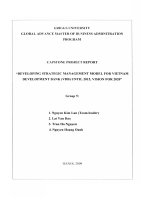Strategic management planning for domestic and global competition 14th ed pearce robinson chapter 7
Bạn đang xem bản rút gọn của tài liệu. Xem và tải ngay bản đầy đủ của tài liệu tại đây (386.3 KB, 40 trang )
Chapter 7
Long-Term Objectives
and Strategies
© 2015 by McGraw-Hill Education. This is proprietary material solely for authorized instructor use. Not authorized for sale or distribution in any manner. This document may not be copied, scanned, duplicated, forwarded, distributed, or
posted on a website, in whole or part.
Learning Objectives
•
•
•
•
•
•
Discuss seven different topics for long-term corporate objectives
Describe the five qualities of long-term corporate objectives that make them useful to strategic
managers
Explain the generic strategies of low-cost leadership, differentiation, and focus
Discuss the importance of the value disciplines
List, describe, evaluate, and give examples of 15 grand strategies that decision makers use in
forming their company’s competitive plan
Understand the creation of sets of long-term objectives and grand strategies options
2
Long-Term Objectives
•
•
Strategic managers recognize that short-run profit maximization is rarely the best approach
to achieving sustained corporate growth and profitability
To achieve long-term prosperity, strategic planners commonly establish long-term
objectives in seven areas:
Profitability
– Productivity
Competitive Position – Employee Development
Employee Relations
-- Technological Leadership
Social Responsibility
–
–
–
–
3
Qualities of Long-Term Objectives
•
There are five criteria that should be used in preparing long-term objectives:
–
–
–
–
–
Flexible
Measurable
Motivating
Suitable
Understandable
4
The Balanced Scorecard
•
•
The balanced scorecard is a set of four measures that are directly linked to the
company’s strategy
Developed by Robert S. Kaplan and David P. Norton, it directs a company to link its
own long-term strategy with tangible goals and actions.
5
Balanced Scorecard (contd.)
The scorecard allows managers to evaluate the company from four
perspectives:
financial performance
customer knowledge
internal business processes
learning and growth
6
Ex. 7.1
The Balanced Scorecard
7
Generic Strategies
•
A long-term or grand strategy must be based on a core idea about how the firm can best
compete in the marketplace. The popular term for this core idea is generic strategy.
8
The Three Generic Strategies
•
3 Generic Strategies:
•
•
Striving for overall low-cost leadership in the industry.
•
Striving to have special appeal to one or more groups of consumers or industrial
buyers, focusing on their cost or differentiation concerns.
Striving to create and market unique products for varied customer groups through
differentiation.
9
Low-Cost Leadership
•
•
Low-cost producers usually excel at cost reductions and efficiencies
They maximize economies of scale, implement cost-cutting technologies, stress reductions
in overhead and in administrative expenses, and use volume sales techniques to propel
themselves up the earning curve
•
A low-cost leader is able to use its cost advantage to charge lower prices or to enjoy higher
profit margins
10
Differentiation
•
•
•
•
Strategies dependent on differentiation are designed to appeal to customers with a special
sensitivity for a particular product attribute
By stressing the attribute above other product qualities, the firm attempts to build customer
loyalty
Often such loyalty translates into a firm’s ability to charge a premium price for its product
The product attribute also can be the marketing channels through which it is delivered, its
image for excellence, the features it includes, and its service network
11
Focus
•
•
•
A focus strategy, whether anchored in a low-cost base or a differentiation base, attempts to
attend to the needs of a particular market segment
A firm pursuing a focus strategy is willing to service isolated geographic areas; to satisfy the
needs of customers with special financing, inventory, or servicing problems; or to tailor the
product to the somewhat unique demands of the small- to medium-sized customer
The focusing firms profit from their willingness to serve otherwise ignored or
underappreciated customer segments
12
The Value Disciplines
•
Operational Excellence
•
Customer Intimacy
•
•
This strategy attempts to lead the industry in price and convenience by pursuing a focus on lean and
efficient operations
Customer intimacy means continually tailoring and shaping products and services to fit an
increasingly refined definition of the customer
13
The Value Disciplines (contd.)
•
Product Leadership
•
Companies that pursue the discipline of product leadership strive to produce a
continuous state of state-of-the-art products and services
14
Grand Strategies
•
Grand strategy
•
A master long-term plan that provides basic direction for major actions for achieving
long-term business objectives
15
Grand Strategies (contd.)
•
•
•
Indicate the time period over which long-range objectives are to be achieved
Any one of these strategies could serve as the basis for achieving the major long-term
objectives of a single firm
Firms involved with multiple industries, businesses, product lines, or customer groups
usually combine several grand strategies
16
Concentrated Growth
•
Concentrated growth is the strategy of the firm that directs its resources to the profitable
growth of a dominant product, in a dominant market, with a dominant technology
•
•
•
Concentrated growth strategies lead to enhanced performance
Specific conditions favor concentrated growth
The risks and rewards vary
17
Ex. 7.4
Specific Options -- Concentration
18
Market Development
•
Market development commonly ranks second only to concentration as the least costly and
least risky of the 15 grand strategies
•
It consists of marketing present products, often with only cosmetic modifications, to
customers in related market areas by adding channels of distribution or by changing the
content of advertising or promotion
•
Frequently, changes in media selection, promotional appeals, and distribution are used to
initiate this approach
19
Ex. 7.4
Specific Options – Market Development
20
Product Development
•
Product development involves the substantial modification of
existing products or the creation of new but related products
that can be marketed to current customers through established
channels
21
Ex. 7.4
Specific Options – Product Development
22
Innovation
•
•
•
These companies seek to reap the initially high profits associated with customer acceptance
of a new or greatly improved product
Then, rather than face stiffening competition as the basis of profitability shifts from innovation
to production or marketing competence, they search for other original or novel ideas
The underlying rationale of the grand strategy of innovation is to create a new product life
cycle and thereby make similar existing products obsolete
23
Horizontal Acquisition
•
When a firm’s long-term strategy is based on growth through the acquisition of one
or more similar firms operating at the same stage of the production-marketing
chain, its grand strategy is called horizontal acquisition
•
Such acquisitions eliminate competitors and provide the acquiring firm with access
to new markets
24
Vertical Acquisition
•
When a firm’s grand strategy is to acquire firms that supply it with inputs (such as
raw materials) or are customers for its outputs (such as warehouses for finished
products), vertical acquisition is involved
•
The main reason for backward vertical acquisition is the desire to increase the
dependability of the supply or quality of the raw materials used as production
inputs
25









